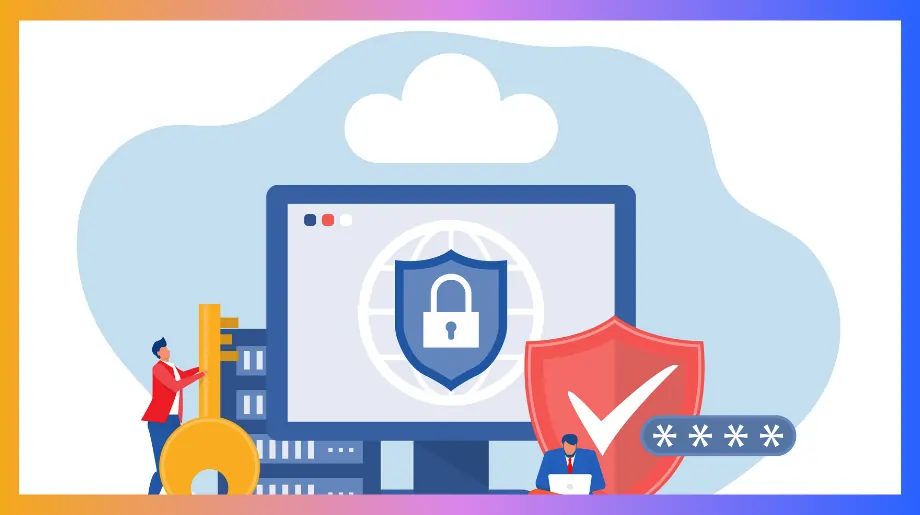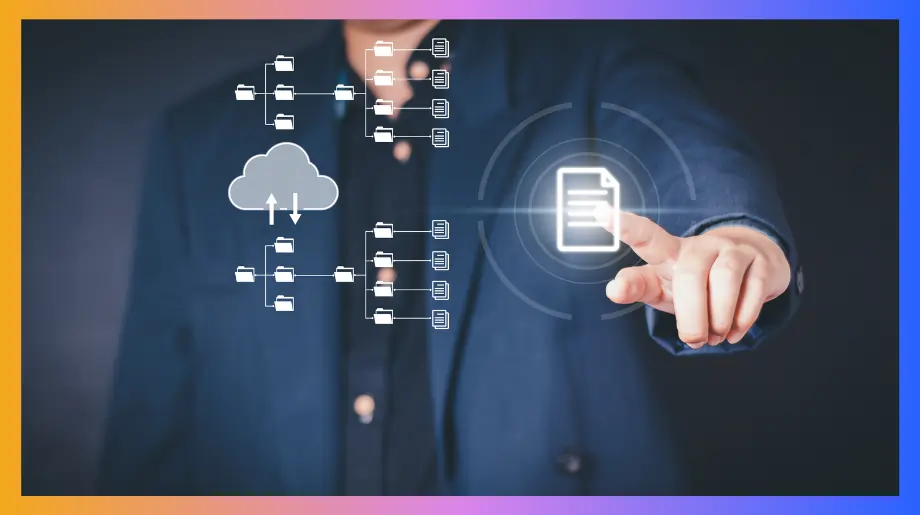Your phone saves photos while you sleep. Your car talks to GPS satellites. Banking systems process money without human help. All these machines talk to each other every day.
What happens when a fake system tries to join them? Your data gets stolen. Your money gets taken. Your systems get attacked.
That's why machine to machine authentication is so important. It stops fake systems from joining real ones. This protects your business and customers.
This guide will teach you how to build secure M2M authentication. You will learn the best ways to keep your machines safe.
What Is Machine-to-Machine (M2M) Communication?
M2M communication means machines talk to each other automatically. They share information to complete tasks.
Here is how M2M communication works in your life:
- Your thermostat talks to weather websites to control temperature.
- Banks check your card in less than a second.
- Your coffee maker starts when your alarm rings.
- Your ride app connects payment, maps, and driver systems.
Understanding M2M Authentication vs M2M Authorization
Your machine systems need two types of protection. First comes authentication - this checks machine identity. Then comes authorization - this decides what machines can do. You need both to stay protected.
What Is Machine-to-Machine (M2M) Authentication
M2M Authentication works like checking ID cards. Before any machine gets access, it must prove its identity. Your system examines credentials and decides if they are legitimate.
Here is how machines prove their identity:
- Present Credentials. Machines show credentials called client IDs, certificates, or API keys. The system verifies if these credentials are authentic.
- Establish Identity. Valid credentials get access permissions. Invalid credentials get blocked.
- Receive Tokens. Authenticated machines get JWT tokens after proving their identity. These tokens work like digital access passes for future requests.
- Automated Process. Systems verify thousands of machine credentials every second. This happens without manual intervention.
What Is Machine-to-Machine (M2M) Authorization
M2M Authorization happens after authentication succeeds. It determines what each machine can do inside your system.
Here is how systems control machine access:
- Assign Permissions. Each machine gets specific permissions it can use. Some can read information. Others can write or modify data.
- Set Boundaries. Systems only let machines access what they need. Payment systems can view transaction information but cannot change personal details.
- Real-time Checking. Every time a machine wants to perform an action, the system verifies permissions.
- Block Unauthorized Actions. If a machine tries to do something it shouldn't, the system prevents it.
Why Do We Need Machine-to-Machine (M2M) Authentication?
Your business systems handle millions of operations every second. Without machine-to-machine communication, nothing would work together. Manual processes would be impossible at this scale.
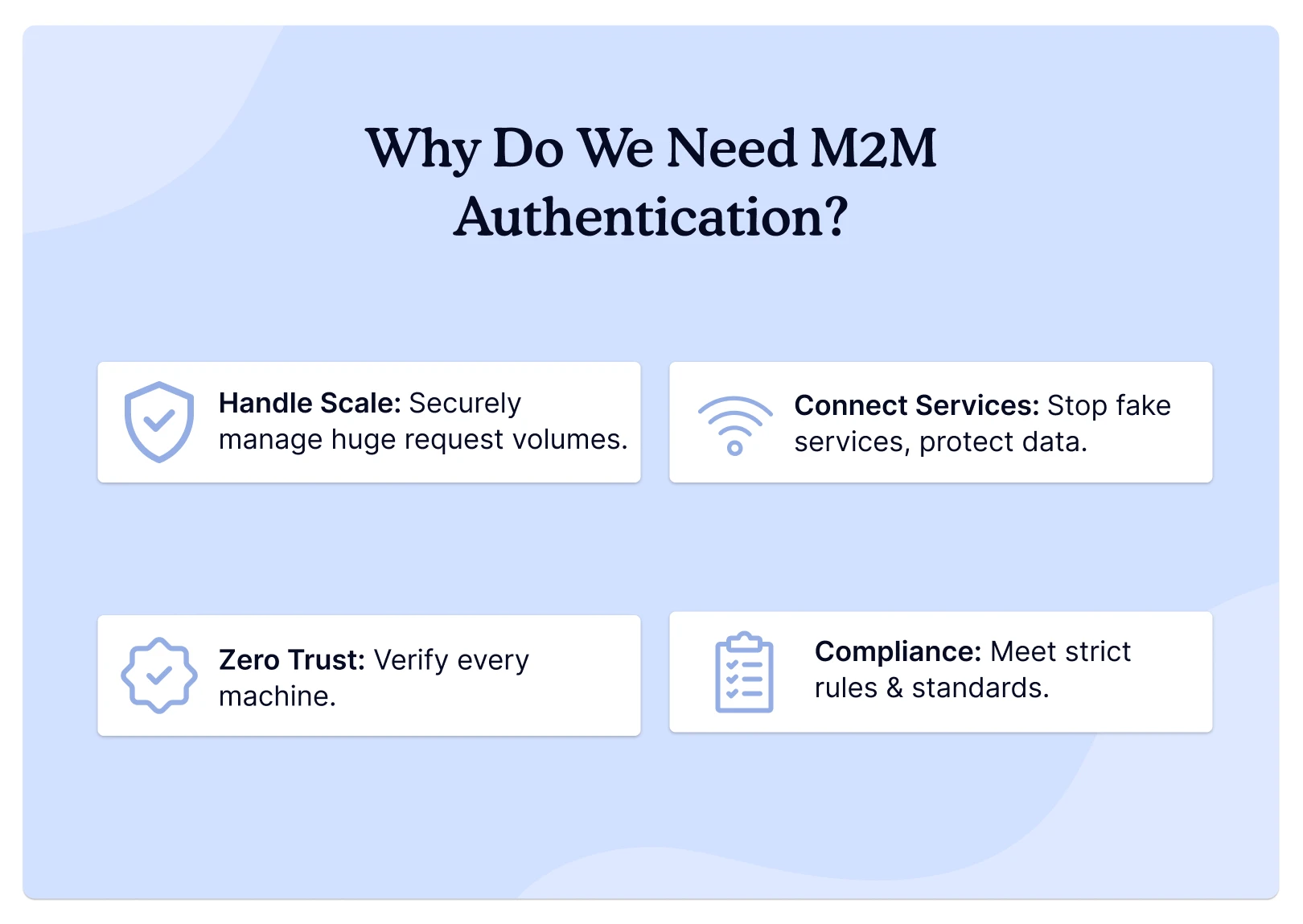
Modern businesses need machines to communicate securely. Here is why M2M communication is so important now:
- Handle Scale. Your applications process thousands of requests every second. Only M2M communication can handle this volume while maintaining speed.
- Connect Services. Today's applications have hundreds of connected services. M2M authentication blocks fake services from accessing your real business data and systems.
- Zero Trust Model. Smart security means no machine gets automatic trust. M2M authentication checks every machine's identity before allowing any business action.
- Meet Requirements. Hospitals, banks, and government agencies have strict communication rules. M2M authentication helps you follow these legal data protection requirements.
How Does M2M Authentication work?
M2M authentication works like a security system for machines. When Machine A wants to communicate with Machine B, it must first prove its identity. No proof means no access.
This security verification happens automatically. Machines use digital credentials like certificates or tokens. The process takes milliseconds but maintains high security.
M2M authentication requires three important components to work together. The client machine wants to gain access. The authorization server verifies credentials and issues tokens. The resource server protects valuable information and validates tokens.
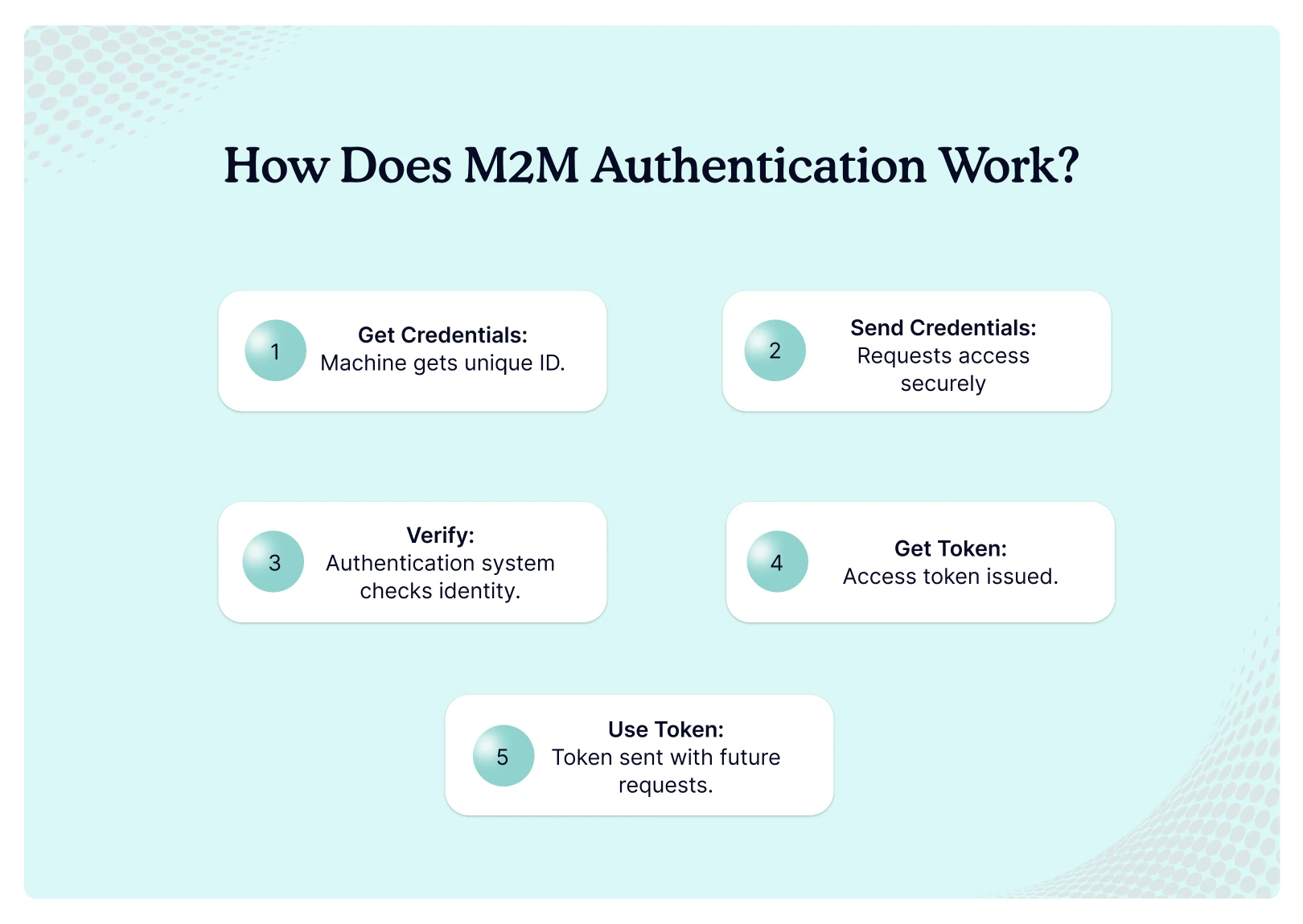
Here is how machines prove their identity:
- Present Credentials. Each machine gets unique credentials during setup. These work like digital fingerprints that cannot be duplicated.
- Submit for Verification. The machine requesting access presents credentials through secure channels. This is like showing identification at security checkpoints.
- Verification Process. The authentication system checks credentials against its database. Everything must match exactly or access gets denied.
- Receive Access Token. When credentials check out, the machine receives an M2M token. This token allows it to perform specific tasks.
- Maintain Security. The machine includes its token in all future requests. This maintains security while avoiding repeated authentication steps.
OAuth 2.0 in M2M Authorization
OAuth 2.0 is the industry standard for M2M authorization. Most business systems use it because it works and maintains security. It works as the universal language that all machines understand.
You can set up OAuth 2.0 in two main approaches. The embedded approach puts everything in one system. The external approach uses separate services. Your choice depends on your system complexity requirements.
OAuth 2.0 uses four main components to manage machine permissions:
- Authorization Server. This central hub issues access tokens after verifying credentials. It maintains records of all registered machines and processes requests.
- Resource Server. This component protects your information and validates incoming tokens. It enforces rules about what each machine can access.
- Client Authentication. Before receiving any token, machines must prove their identity. This happens through credentials, secret codes, or certificates.
- Access Tokens. These represent permission to perform specific operations. They contain identity information and expire after a predetermined time.
Client Credentials Grant Flow
This is the most common OAuth method for machine communication. No human users get involved. It's pure machine interaction that is fast and secure.
Embedded Authorization Server Approach
Your main server handles everything internally. It verifies credentials, creates tokens, and protects resources in one system. This simplifies architecture but centralizes all responsibility.
Here is how the embedded approach operates:
- Credential Submission. The machine presents its credentials to your main server. This happens through secure web protocols.
- Internal Token Creation. Your server verifies credentials and generates access tokens. No external systems participate in this process.
- Resource Access. The same server that created tokens also protects resources. Everything happens within one system for maximum efficiency.
External Authorization Server Approach
Your main server delegates credential verification to external specialists. This distributes work between different systems.
Here is how the external approach operates:
- Delegate to Specialists. Your server sends credential verification requests to external services. These experts handle authentication and create tokens.
- Token Reception and Validation. Your server receives tokens from specialists and validates them. This can happen through token inspection or signature verification.
- Centralized Management. External specialists handle multiple applications. This creates consistent security policies across your organization.
JWTs vs API Keys in M2M Authorization
You must choose between JWT or API key for your machine systems. Both methods give machines permission to access resources without sharing passwords. They work in different ways though.
JWTs work like smart ID cards that prove identity without revealing secrets. This is called zero knowledge proof - machines can prove who they are without sharing private information. API Keys are simple digital passes that need database checks.
Your choice affects system performance, security level, and growth ability. Distributed systems with many services prefer JWTs. They work without needing other systems. Centralized systems with single databases often choose API Keys. They are simpler to manage.
When JWTs Work Better
JWTs work like smart ID cards. They carry all necessary information inside them. This means your system doesn't need database permission checks.
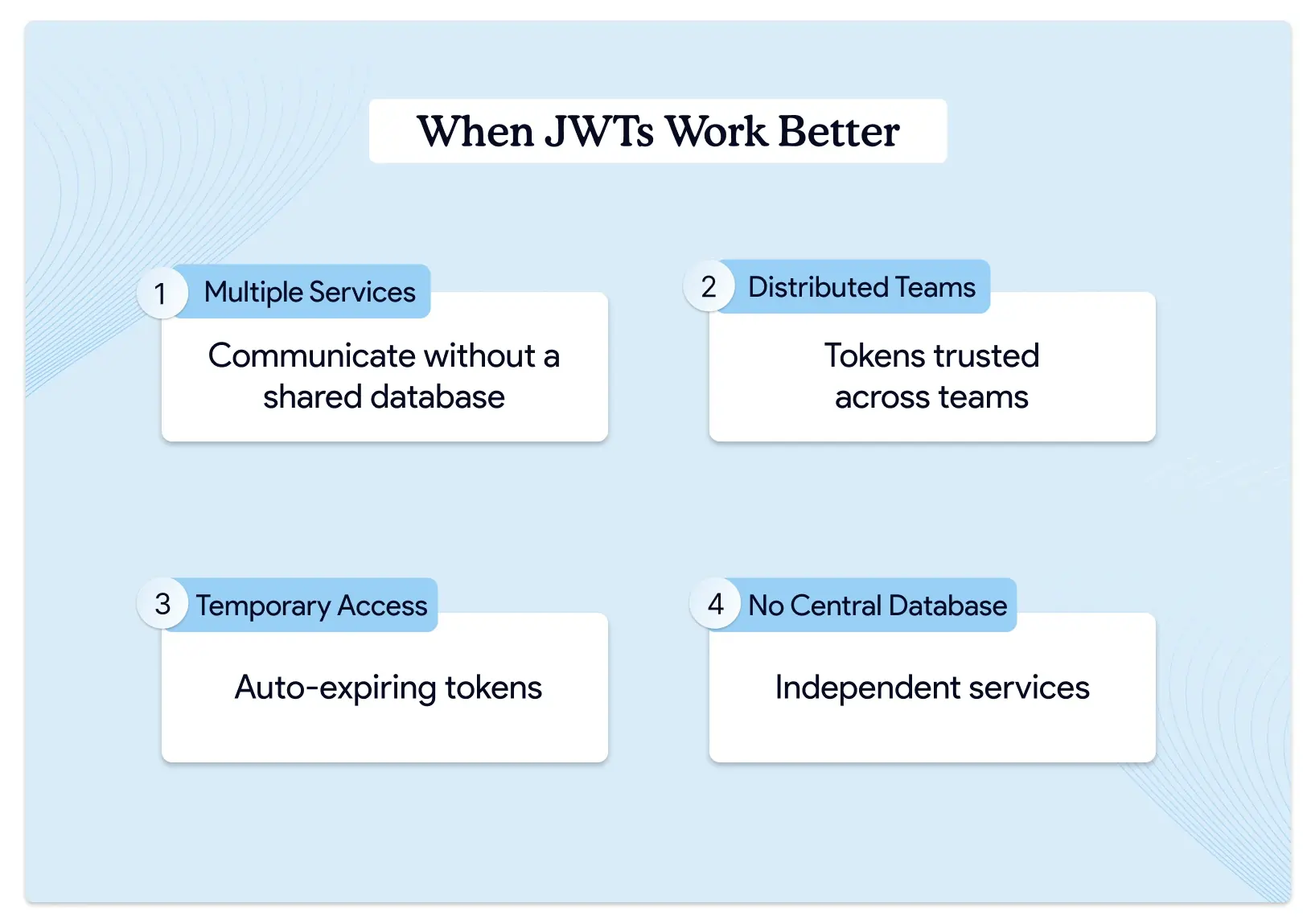
Here is when JWTs help your M2M systems:
- Multiple Services Setup. When your app has many services that need to talk together without sharing one database.
- Distributed Team Work. When different teams build services that must trust each other's tokens across locations.
- Temporary Access Needed. When you want tokens that expire automatically after set time without manual removal.
- No Central Database. When services work independently and cannot easily check one shared database for permissions.
Use JWTs when you have: Multiple connected services, distributed teams, temporary access needs, or no central database.
When API Keys Work Better
API Keys work like simple membership cards. They are easy to understand and manage. Perfect when you need control over access permissions.

Here is why API Keys work well:
- Simple Setup. API Keys are basic strings that check against databases. No complex token parsing or signature verification needed.
- Instant Removal. Remove API Keys from your database to block access. No token blacklists or cache management required.
- Database Control. Link each API Key to specific permissions and user accounts. You control what each machine can access.
- Small Network Traffic. API Keys are tiny strings that don't impact bandwidth. Perfect for high-frequency API calls.
Use API Keys when you have: Single application setup, shared database, long-term access needs, or simple team requirements.
Real-World Use cases of M2M Authentication and Authorization
M2M authentication happens everywhere in your daily life. You don't see it happening. Machines prove their identity to each other constantly. This keeps your digital world secure.
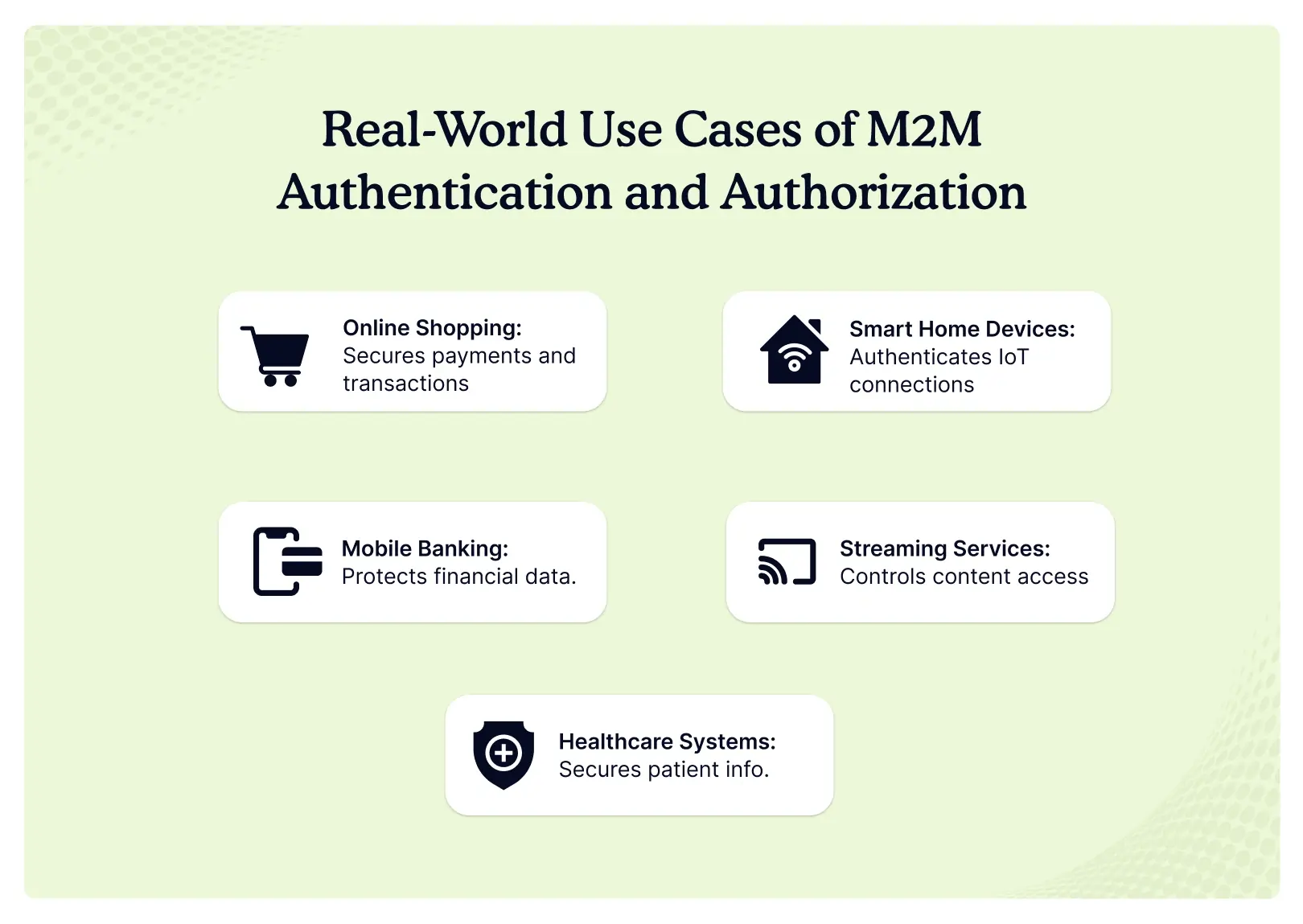
Here is where M2M authentication protects you:
- Online Shopping. When you buy something, the shopping website talks to payment systems. Payment systems check with your bank for approval. All these connections use machine to machine authentication to keep money safe.
- Smart Home Devices. Your thermostat connects to weather services for temperature data. Your security system talks to monitoring companies about alerts. Each connection requires proper authentication before sharing data.
- Mobile Banking. Your banking app connects to account servers to show balance information. It talks to transaction systems for money transfers. Every connection gets verified to protect financial information.
- Streaming Services. Netflix talks to content delivery networks to stream movies. It connects to recommendation systems for viewing suggestions. Authentication ensures only approved services access your data.
- Healthcare Systems. Medical devices send patient readings to hospital databases. Insurance systems connect to verify coverage information. Authentication protects sensitive health information during every exchange.
Best Practices for M2M Authentication and Authorization
Building secure M2M systems requires careful planning from the start. You have seen news stories about major data breaches. These attacks cost companies millions of dollars. They happen because organizations make the same security mistakes.

Here are security mistakes that companies make and what you should do instead:
- Shared Credentials Across Services. Many companies use one API key for multiple services. This creates dangerous failure points. When attackers compromise one service, they gain access to everything. Instead, give each machine separate credentials for system access. Unique identity reduces security risks across your entire system.
- Long-Lived Static Tokens. Some tokens never expire and become permanent security vulnerabilities. Once criminals steal these credentials, they maintain unlimited system access. You should change authentication tokens every 90 days or less. Short-lived credentials reduce security exposure when systems get compromised.
- Weak Certificate Management. Companies often use self-signed certificates and poor validation practices. This creates security gaps that criminals exploit to impersonate legitimate services. Use digital certificates that provide stronger security than passwords for machines. They offer stronger identity verification and support renewal.
- No Authentication Monitoring. Systems without proper logging miss suspicious activity patterns. Failed authentication attempts go undetected until major damage occurs. Log all authentication attempts and authorization decisions. Real-time monitoring helps detect suspicious activity before incidents occur.
- Always encrypt all communications using TLS 1.3 protocol. This protects data transmission between machines and prevents attackers from intercepting sensitive information. Monitor authentication events in real-time to analyze patterns and detect problems before they cause damage.
Future Trends and Challenges in M2M Authentication
M2M authentication faces new challenges every day. Technology advances create opportunities and threats. Your security strategy must evolve with these changes.
Here are key trends shaping M2M authentication:
- AI-Powered Security. Machine learning algorithms analyze authentication patterns to detect problems. These systems identify suspicious behavior and flag potential breaches. This happens before they cause damage.
- Quantum Computing Threats. Quantum computers will break current encryption methods within ten years. Organizations need to prepare new cryptography solutions now. This protects future communications from quantum attacks.
- Edge Computing Growth. More devices process data locally instead of cloud servers. This requires new authentication methods for limited internet connections. Edge devices need security that works offline.
- Zero Trust Setup. Traditional network boundaries no longer exist in modern systems. Every machine interaction requires verification regardless of location. Previous trust relationships don't matter anymore.
- Privacy Rules. New laws like GDPR and CCPA demand stronger data protection. Compliance requirements affect how organizations design M2M security systems. Privacy must be built into authentication processes.
Using Infisign for M2M Authentication That Works With All Ecosystems
Your business cannot survive without secure M2M authentication anymore. Every machine connection, every API call, and every automated system needs bulletproof security.
The future demands passwordless M2M authentication that works through zero trust principles. Infisign revolutionizes M2M authentication with next-generation identity management.
Built on zero trust architecture, Infisign eliminates passwords entirely while delivering enterprise-grade security.
Our platform uses JWT tokens combined with Zero Knowledge Proof technology to secure machine communications without exposing sensitive data.
Here's how Infisign transforms your M2M authentication:
- Zero Trust M2M Security. Every machine request gets verified through a cryptographic proof. No unauthorized access even from inside your network.
- Passwordless JWT Authentication. Machines authenticate using signed tokens instead of static passwords. This eliminates credential theft and password attacks.
- Zero Knowledge Proof Technology. Machines prove their identity without revealing secret information. This maintains privacy while ensuring security.
- Decentralized Identity Management. Each machine controls its own identity credentials. This reduces single points of failure and improves system resilience.
- AI-Powered Threat Detection. Machine learning algorithms analyze authentication patterns. They detect suspicious machine behavior before breaches occur.
- Privileged Access Management. Granular control over which machines can access specific resources. Follows least privilege principles automatically.
- Real-Time Monitoring and Compliance. Complete audit trails of all machine authentication events. AI-powered reporting for regulatory compliance.
- Seamless Integration. Pre-built APIs and SDKs integrate with your existing infrastructure in hours. Supports OAuth 2.0 and modern protocols.
Ready to eliminate M2M security vulnerabilities? Experience the future of machine authentication today. Get Your Free Demo!
FAQs
What is the difference between M2M and API key?
M2M authentication is the complete security system for machine communication. API keys are one tool used within that system. M2M works as the security department. API keys are like ID badges.
M2M authentication covers the whole process. How machines prove identity, get permissions, and communicate securely. It includes OAuth tokens, certificates, JWTs, and API keys as credential options.
API keys are simple string identifiers that machines use to access services. They are one type of credential within the M2M security framework.
What is an example of a M2M?
When you buy something online, machines authenticate with each other. Your order service talks to the payment service. The payment system authenticates with your bank and fraud detection services. All this happens in seconds without human help.
Is M2M safe?
Yes, M2M authentication can be safe when set up well. It uses strong cryptographic algorithms and standardized protocols like OAuth 2.0. Poor credential management or weak setups create vulnerabilities. The key is following security best practices. Use proper encryption and maintain updated systems.





